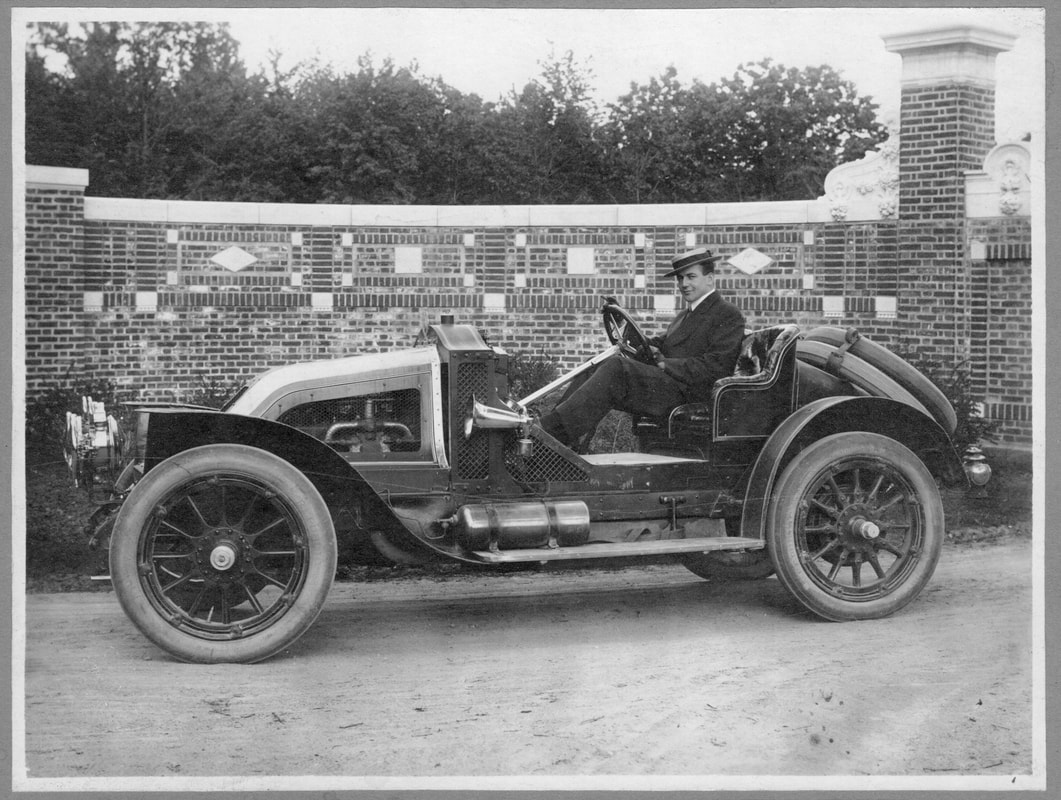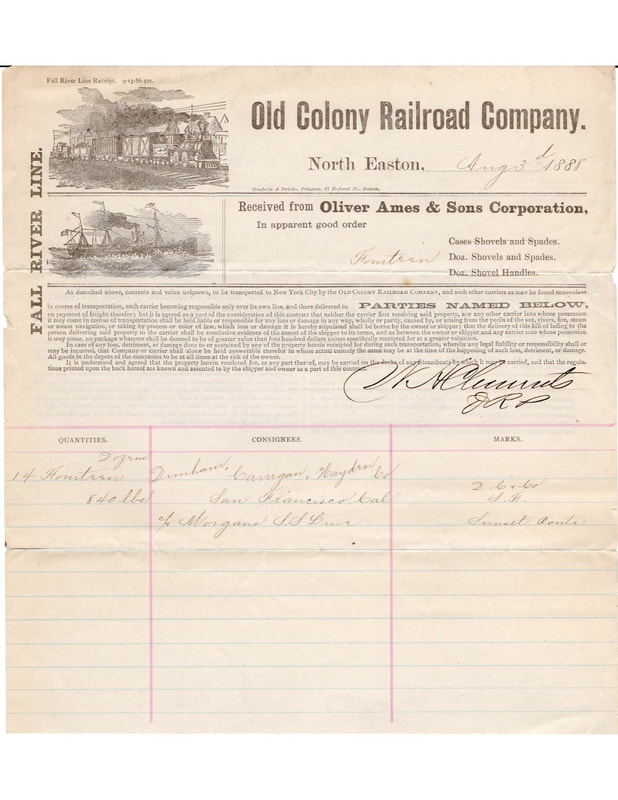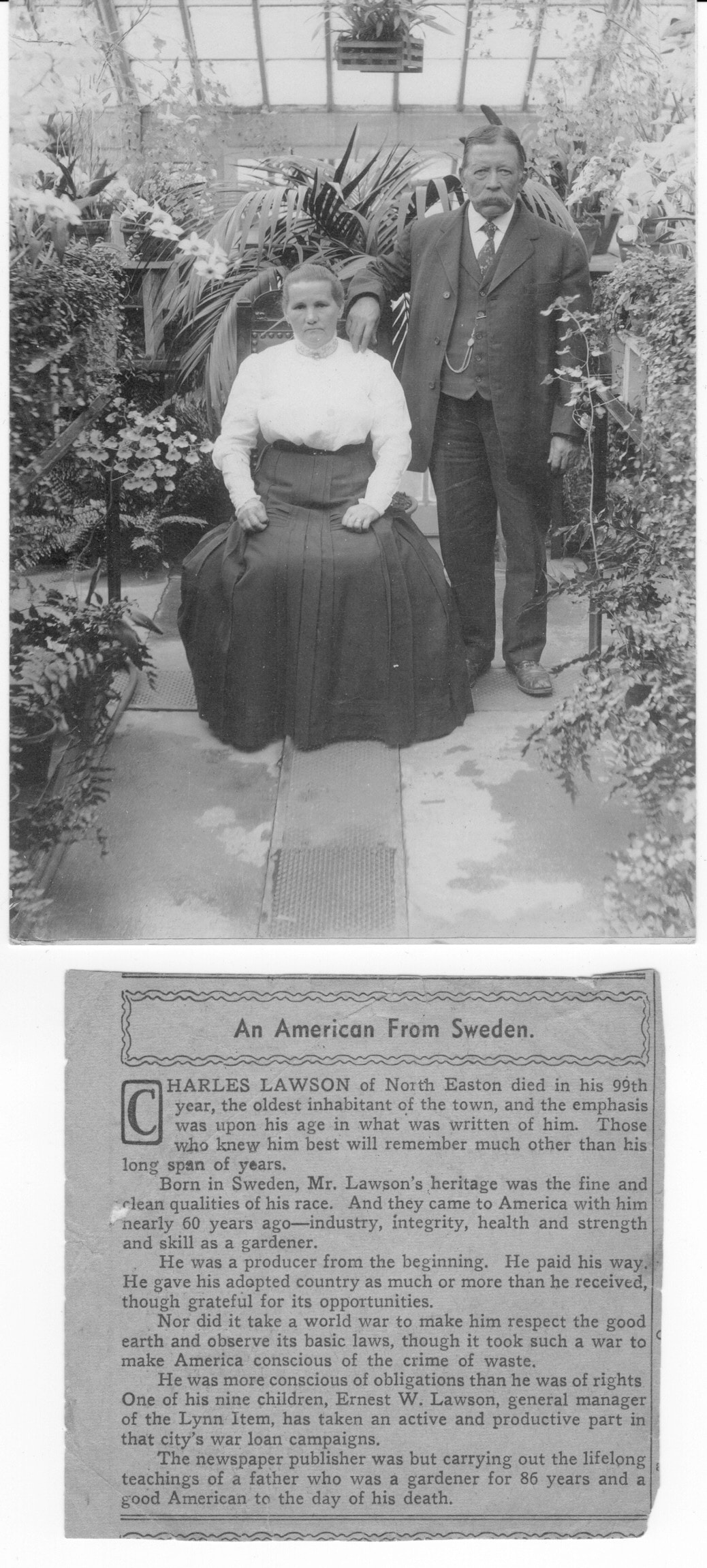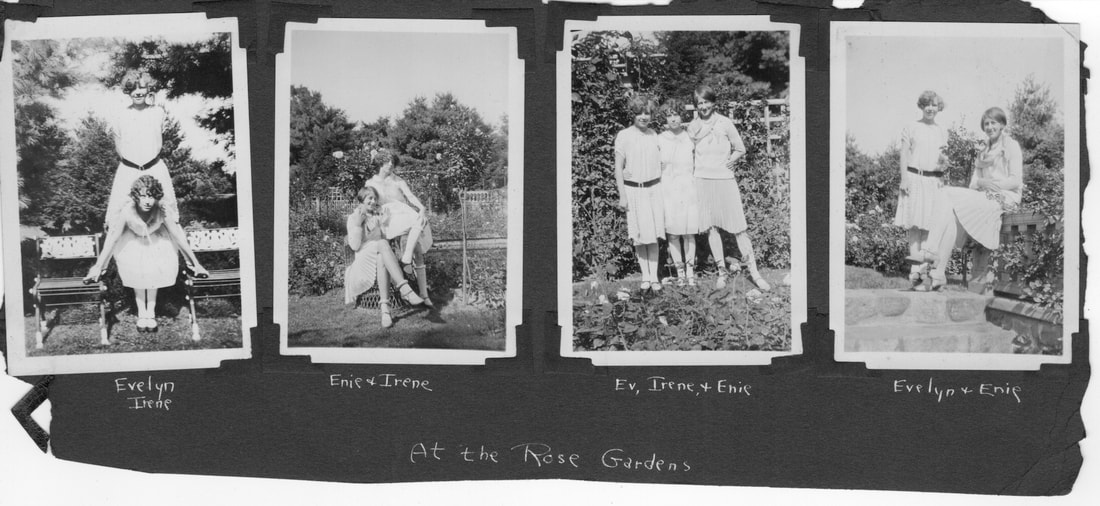|
Happy Saturday morning! A cool and calm day in Easton is much welcomed after a long, hot, humid week. Our thoughts today are with our members and friends affected by Hurricane Henri last week, and with those preparing for Hurricane Ida to make landfall in Louisiana sometime Sunday.
This week, my dear friend Lee Williams dropped in with a wonderful surprise. A few years ago he purchased, at a fundraising auction, an original photograph of the second Frederick Lothrop Ames in a Renault automobile. He is sitting at the wheel of the car, and the photo was taken at his home, Stone House Hill House, better known today as Stonehill College (his former home is Donahue Hall). The photo is a wonderful photo of Mr. Ames, known as Lothrop, but with all due respect to the Ames family, it is the car that steals the show. The story begins with William K. Vanderbilt of the wealthy Vanderbilt family. As a young boy in the 1880’s, he visited France with a family friend, and rode in a three-wheeled French steam powered car. He was most amazed at the speed at which they were able to travel (Vanderbilt himself would break the land speed record - twice!). That love of speed led him into taking an active interest in auto racing, and when a Renault car won the first ever French Grand Prix style event in 1905, he contacted the company about building race cars so he could introduce the sport to the American market. In 1907 Renault delivered eleven custom built race cars at a total cost of $150,000. Vanderbilt had agreed to take all eleven cars and found owners for ten of them, keeping one car for himself. There was one difference in each car - the seating was customized to the size and needs of the prospective owners. Soon Vanderbilt began a race in Newport, Rhode Island, which later moved to Long Island and became the Vanderbilt Cup race. For many years it was the premier auto race in America. One look at the photo quickly shows this was not a “normal” car for its time. Some thought of reducing drag is evident in the car’s aerodynamic design. Powered for a four-cylinder 7.5 liter engine that could develop up to 65 horsepower, and coupled with a four speed progressive transmission, the car had plenty of get-up-and-go, winning a number of early races. Semi-elliptical leaf springs and mechanical hub brakes rounded out the basic needs. The car was equipped with special removable wheel frames that helped to speed up pit stops. Another innovation was the mounting of the massive radiator near the center of the car, which improved its handling. I am not sure whether or not Lothrop owned this car at one time or if a friend visited with it. It is a rare photo of an important early race car. Of the eleven original cars built, only four are known to survive in America, and in 2020 one example was sold at auction for $3.3 million dollars. Check out this link https://www.bonhams.com/auctions/25719/lot/159/ for more information! Stay safe, stay well, and until next week, Frank
0 Comments
Hello all! What a difference a week makes. I am battening down the hatches at the Museum as we prepare for Henri. It may be the worst storm in thirty years, so we have been watching it carefully, moving things away from windows, etc. to protect our collections. Living in the wooded area near Borderland State Park, I fully expect to lose power for a while (we usually do) so I will be filling my thermos with hot water tonight before bed so I can have that ever important morning coffee tomorrow! I hope that the Museum , as well as all of you, come through the storm safely.
This morning I have just a quick little item to share with you. It is a bill of lading for the Old Colony Railroad dated August 3, 1888. The document is for the shipment of 14 dozen shovels from the Oliver Ames & Sons Corporation to Dunham, Carrigan, and Hayden Company, San Francisco, California. We know a lot about the sender, but the recipient was a well-known merchandiser of hardware, housewares, etc. to the mining industry. Founded about the time of the California Gold Rush in 1849, the company had a full line catalog - the Sears of the west coast. Their building was about a city block long! Besides being a major supplier of mining equipment, which is probably the destination of these Ames shovels, they also played a major role in the rebuilding of San Francisco following the 1906 earthquake and fire. The bill head itself is a great item. The engravings of the steam train and the steam ship highlight the various means of sending freight all over the country. A read through the shipping notes is worthwhile too. Hoping you all weather the storm, Frank Happy Saturday to my fellow lovers of all things historic! It has been very hot this week, with temps approaching 100 degrees and accompanied by summer’s ever-present humidity. Ice water and a cold salad for lunch never tasted more refreshing than it has this week.
While going through the recently donated papers of the Lawson family, I came across this photo and tribute to a man, Charles Lawson, who came from his native Sweden and worked hard to become successful in his adopted country of the United States. The photo is a formal portrait of Charles Lawson and his wife Christina (Johanson). He was born June 29, 1845 in Sotterby, Socken, Nabara, Sweden. She was born in Horreb, Socken, Nabara, Sweden on September 15, 1845. The couple married in Sweden on June 29, 1877, and eight years later came to North Easton, where Mr. Lawson took a job as a gardener at the estate of Cyrus Lothrop. You may know it better as the Parker Estate, or its historic name, Unity Close. Lawson spent the next forty-eight years working for Lothrop and Mr. and Mrs. Parker, retiring at the age of 86. Following his retirement, he continued to stay active walking daily to North Easton Center and enjoying automobile rides. When he turned 97 he was the oldest man in Easton. He died the following year, 1944 at age 98. His wife died eight years prior. The couple had nine children, some of whom you might know – H. I. Ingman of Salem, N.H.; Mrs. Ida Jacobson, Charles H. Lawson, Mrs. John Stromvall, Mrs. John Hanson, Mrs. Albin Anderson, Miss Esther Anderson, and Harry Lawson, all of Easton; and Ernest W. Lawson of Brockton. With such a long life came the pleasure of seventeen grandchildren and seven great-grandchildren. The photo was taken in the greenhouse or conservatory on the rear of the Unity Close property. The writeup titled “An American From Sweden” is from an unnamed source, but may have been from a newspaper in Lynn, MA. where one of his sons, Ernest, was a publisher and general manager. The tribute speaks briefly about what he did, but makes more of a point about the character of the man. As an immigrant from Sweden, he worked hard to contribute to his new country, bringing with him “industry, integrity, health and strength and skill as a gardener.” He clearly did not want to be a burden to anyone. He appreciated the opportunities granted to him, and tried to make sure he could give more than he received. As the column notes in its closing, Charles Lawson passed onto his children the above-mentioned qualities, with son Ernest “carrying out the lifelong teachings of a father who was a gardener for 86 years and a good American to the day of his death.” Charles Lawson is one story out of the many stories of those who came from Sweden to Easton to seek out a new life. He achieved the “American Dream” and worked hard for it. He made sure he passed that dream along to his children with an appreciation for what they had and what it took to get it. He was indeed a “good American.” Until next week (and a week closer to fall!), Frank Greetings! Summer weather made a spectacular return late this week and it looks like August might provide the best weather of the season. The sun is certainly bringing out the visitors and walkers and finally fostering some outdoor activities.
One of the special sights of any summer would be a glimpse into Mrs. Frothngham's Rose Garden at her Elm Street home "Wayside." This garden attracted both national and international attention for its wide variety of specialty roses and architectural layout and elements. Secreted away to the northwest of her home, which is now the Easton Town Offices, the Rose Garden was a place of finely manicured beauty. America's best rose experts, landscape architects, and gardeners created and maintained one of Easton's true "hidden gems." The photo album we received last week included a real surprise - four photos of three great friends posing in Mrs. Frothingham's Rose Garden! These pictures were probably taken around Class Day for the Oliver Ames High School Class of 1929. The young graduates, fresh faced and finely dressed, are Evelyn (Ev) Lawson, Enis (Enie) Larson, and Irene Mahan. They strike a balance of both formal and fun poses as they commemorate their day together. It must have been quite an honor to have their pictures taken at the Rose Garden! Evelyn would later marry Andrew Costello, and it is her daughter Nancy (Costello) Spindler who donated the album kept by her mother. Enis would marry Harland Almquist, and their daughter Priscilla Almquist-Olsen spent time at the Museum this week to help identify people in the album. I do not know too much about Irene Mahan and I hope someone reading this might provide more information on her. Ev Lawson's father Charles was a gardener at Unity Close, and provided the connection for the girls to make an appearance at the Rose Garden. Until next week, stay well, and enjoy the summer! Frank Frank T. Meninno Curator, Easton Historical Society and Museum 508-238-7774 |
Author
Anne Wooster Drury Archives
June 2024
Categories |
Easton Historical Society and Museum
PO Box 3
80 Mechanic Street
North Easton, MA 02356
Tel: 508-238-7774
[email protected]




